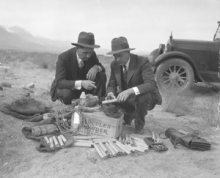Article
A nitroglycerin-based explosive material often used for construction, mining, and demolition. Dynamite was patented in 1867 by Alfred Nobel, a Swedish chemist, and ironically, the inceptor of the Nobel Peace Prize. The name “dynamite” comes from the Ancient Greek work for “power”, δύναμις (dýnamis). Dynamite is composed of earthy materials, such as sawdust, soaked in nitroglycerin, which when exposed to heat can cause a detonation. If left in storage for too long, nitroglycerin can seep from the sawdust into surrounding materials and make the dynamite unstable, thereby causing unexpected explosions. Today, dynamite is wrapped in plastic or a wax-coating to eliminate this risk.
"Two men examining a kit of dynamite and wire found during sabotage incidents of Owens Valley Aqueduct, Southern California, circa 1924" by the Los Angeles Times
Manuscripts
A05 Listening Woman (02-13) p.199
A05 Listening Woman (02-13) p. 200
A05 Listening Woman (02-13) p. 206
A05 Listening Woman (02-13) p. 207
A05 Listening Woman (02-13) p. 221
A05 Listening Woman (02-13) p. 226
A05 Listening Woman (02-13) p. 227
A05 Listening Woman (02-13) p. 229
A05 Listening Woman (02-13) p. 236
A05 Listening Woman (02-13) p. 238
A05 Listening Woman (02-13) p. 239
A05 Listening Woman (02-13) p. 241
A05 Listening Woman (02-13) p. 243
A05 Listening Woman (02-13) p.244
References
The American Heritage Dictionary
2003 Dynamite. Dictionary of the English Language, Fourth Edition.
http://www.thefreedictionary.com/dynamite, accessed October 8, 2014.
Encyclopædia Britannica Online
N.d. Dynamite. http://www.britannica.com/EBchecked/topic/175198/dynamite, accessed
October 08, 2014.

